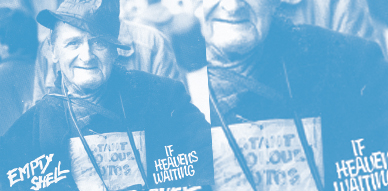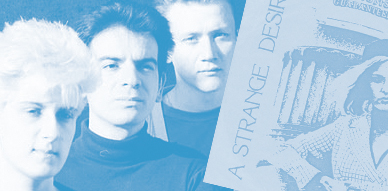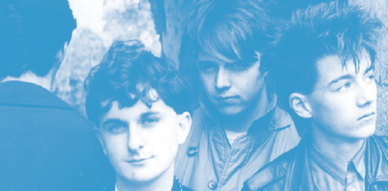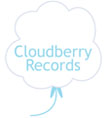May
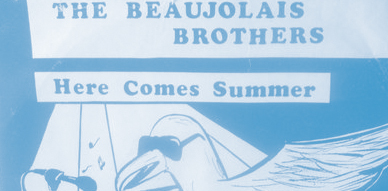
Thanks so much to Micky for the interview and his wife Victoria for getting me in touch with him after I had written about them on the blog. The Beaujolais Brothers were Rodney and Micky, sadly Rodney passed away in October 2008, so Micky is now the only surviving “Brother”. The two of them were in many bands together and even though they didn’t release many records, The Beaujolais Brothers 7″ is a classic in my book. There was not much information about them on the web so I always wanted to learn more about them. I was lucky that Micky answered my questions with lots of details. Felt like I was transported to the Beaujolais Brothers time. Hope you enjoy this interview!
++ Let’s start from the beginning, from your first music memories. Like when growing up what sort of music did you listen to at home? Were your parents into music? What was your first instrument?
I shared a small flat with my mum, nan and uncles in South London. My mum was a teddy-girl and my uncles were teddy-boys, we all listened to rock-n-roll, especially Little Richard, a lot of American black artists, but not so much to Elvis. We used to listen to Forces Family Favourites, on the BBC which was for people based in Germany. They played lots of different songs from different places.
I would listen to Radio Caroline and Radio Luxembourg underneath the bed-covers. They were independent radio stations and the DJs on them went on to BBC Radio 1 in the 60’s.
My first instrument was at school – a bass drum in the junior orchestra and I still have the melody in my head.
I got into guitar later on, in my late-teens. When I was 18 or 19, I learnt 3 chords and started playing gigs; I never learned the guitar properly until later on.
++ Were you involved in any other bands before The Beaujolais Brothers? If so, care telling me a bit about each of them?
In the late 70s I was playing with a band called ‘KP and the Peanuts’ and Rod had joined ‘the Heroes’, a local Croydon band (Dave Berk’s manor). Rod and I were both born in South London; Rod was born above a radio repair shop and he was one of seven. We lived round the corner from each other, but we didn’t play in a band until much later. We didn’t go to the same school for example and he was a year younger than me. We both played in different bands. When we started playing together he was in a band called ‘Red Socks’. Tony Bulldock was in that band and he later did the artwork for the Beaujolais Brother single – he created Cedric the Seagull. Gerry Shephard (who was guitarist with Gary Glitter https://en.wikipedia.org/wiki/The_Glitter_Band) and Tony Day were also in that band.
There was a lot in between which I can’t now remember. I was in a middle of the road rock band called ‘Shade To Far’ and we wrote our own songs. That band was Ricky Hammond, Terry Kavanagh, Tony Bulldock and me. Our bands used to rehearse in the same studio in Streatham called ‘the Pit’; and I was jealous of Rod’s band and he was jealous of mine.
Then Gerry left Red Socks to join the circus (he and Gary Glitter went off to join the circus and they thought they could put rock into the circus…https://books.google.co.uk/books?id=xmT0CQAAQBAJ&pg=PT115&lpg=PT115&dq=gary+glitter+join+the+circus&source=bl&ots=ZaNtk_vbY4&sig=VLt8PVwlstGjPrkXKQHzte2iHGc&hl=en&sa=X&ved=0ahUKEwj26LW_lOTZAhUmD8AKHWULAMUQ6AEIRzAI#v=onepage&q=gary%20glitter%20join%20the%20circus&f=false) and I was asked to join the Red Socks. The Red Socks went onto become ‘the Dolephins’, which was a mad covers band (e.g. from 1950s to 80s stuff but in our own whacky style). We’d have certain themes for the gigs, ‘Dolephins of Sherwood Forest’ or ‘Dolephins go to Tahiti’ (there are some pictures on Rod’s Facebook page).
How it started I was in the ‘White Lion’ pub in Streatham, South London. On a Sunday afternoon, they had a band, the governor of the pub asked me to do a couple of songs with the band. I did ‘Johnny be Good’ and ‘Aint that a Shame’. I got free beer and £20, the governor offered me a regular gig on a Friday night; so I had to form a band, a proper band. So ‘The Dolephins’ was formed. We had various singers one of whom later became a singer with the Sexed Up Lambeth Boys – Paddy. I played lead guitar and Rod played rhythm. ‘The Dolephins’ played various pubs in South London, including ‘The Crown and Spectre’ which was made famous by Mick Jones of ‘The Clash’. We had a weekly spot, that was the beginning and we later became The Sexed Up Lambeth Boys. We played things like ‘Sorrow’, ‘Stepping Stones’ and ‘Walking the Dog’.
++ How did you and Rodney meet? Did you start the band immediately?
My first gig was in the Corn Exchange in Ashford; supporting a band called ‘Dirt’. We were called ‘Danny Diarrhoea and the Wet Farts’, circa 1977. Rodney was guitar player in Dirt at that time. We knew each other as we live close-by when we grew up, but we didn’t socialise together.
++ Why the name The Beaujolais Brothers? Would Beaujolais be your favourite wine?
You are correct about how we got the name the Beaujolais Brothers. We had gone to France for the vendanges (grape picking) it was about wine, lots of wine, drinking it, and grape picking.
++ So you were a busking band. So wondering whereabouts did you busk, what were your favourite spots?
Rod and I played constantly – we busked every day. We had a regular busking spot outside the toilets by a shopping centre in West Croydon. We used to hear a harmonica player coming from the toilets; it was the toilet cleaner who wanted to be our manager. He would make us cups of tea if we weren’t making any money. If we made money, we would have a beer – usually Fullers ESB. We would play anywhere, parties, gigs, we once supported ‘Postman Pat’ (a children’s TV character) in Preston Park in Brighton; walking behind him singing the theme tune to the TV show https://en.wikipedia.org/wiki/Postman_Pat.
++ What would you say were influences to The Beaujolais Brothers sound?
I was a huge fan of 60s bands like, the Kinks, Small Faces, The Who, Gerry and the Pacemakers, Staxs and Tamla Motown. I was never a huge Beatles or Rolling Stones fan and I wasn’t really into mainstream. Rod loved the Beatles though.
++ How was the creative process for The Beaujolais Brothers?
We thought about doing a Beaujolais Brother’s single. I’d started writing the song ‘Here Comes Summer’ as I used to bunk off work in London and jump on a train to Brighton on the south coast. I’d write down silly words and they became Here Comes Summer; written through numerous visits to Brighton.
Rod had a tape-recorder and we would write silly songs, like ‘Ping Pong’. Which went – ‘love is like a game of ping pong…’ and the harmony went ‘ping pong, ping pong…’
++ You released just one single, “Here Comes the Summer” with “Day After Day”. Wondering if it is not much to ask, if you could tell me in a couple of sentences what is the story behind each song?
When we did ‘Day After Day’, Dave wanted to be Frank Sinatra. Also, he didn’t get on particularly well with Andy Dalby the engineer and producer of the recording sessions. Andy Dalby was quite adverse to people drinking in the studio, so we’d wind him up by coming in at 8am with a bottle of Jack Daniels. By the time we’d recorded the drums, it was 11am and the pubs were open. We recorded it on tape so if you made a mistake, you’d have to start again and go right back to the beginning and do it all again. So for Andy it was not a pleasant experience, especially recording the vocals with Dave as it nearly ended in a big fight every time he got it wrong; which was most takes.
The sound effects (the fun-fair and seagulls) were taken from a BBC sound effects library record. That cost us more money as we had to buy two different records – they are probably still available today.
To make it stereo, we had to record it twice to make it go out of each speaker, which was very boring. So the pub round the corner from Cherry Studios got a lot of our money. Both middle-eights and solos were made up in the studio. We also used a little Casio keyboard in the studio.
‘Day After Day’ was our version of ‘The Girl From Ipanema’ (I wish it was) and yet again we made up the solo in the studio. When we finished recording we had to wait for a date to put the single onto acetates. We had to go to the Edgeware Road on a freezing cold day, to meet a man from ‘Triple A Records’, who were pressing the single. We met a guy called George who was mixing the single and he was one of the greatest blokes ever. While he pressed the single, his workshop was right next door to a pub and he had an archway between the workshop and the pub which he could use to go to the pub anytime he wanted while he was working. He had mastered on ‘Let It Be’ for the Beatles which really impressed Rod.
++ This record was self-released on your own Seagull Records. How was the experience of selling the records, distributing them? And why is the catalog number CORK 001. Why Cork? Because the cork of the wine perhaps?
Everything to do with the single had to be based on drink, so when we went through George’s archway to the pub and chatted, he was the one who came up with the ‘cork 1’ on our single. If you look at the single, you’ll see his own private message, which was very special to us. It says ‘A PORKY PRIME HIC-CUT’. ‘Porky’ was his pressing place and he said it was a ‘HIC-CUT’ from him. Rod loved the Beatles and we both loved it that he came up with ‘cork 1’ and he was on the same wavelength as us.
++ And tell me a bit about the recording session for this record. Where was it recorded? Who produced it? How long did it take? How many copies were pressed?
One day in the pub we decided we’d record ‘Here Comes Summer’ and ‘Day After Day’; another song which I had written which was lying around in numerous different versions. Neither of us was earning much money, so we thought we’d record the single, which we did in 1988. At the time it cost us about £1,000 for the recording and pressing. We recorded it at Cherry Studios, Cherry Road, Croydon. We have an idea of how the songs should sound, but both songs were very rough – and still are.
We didn’t have a drummer, so we used a drum machine – a Roland 505, which was the hardest thing to program. Dave Crawley was a computer programmer and a singer with ‘The Heroes’. So we got Dave to program Roland with Rod and he then sang on ‘Day After Day’. The drum machine was a nightmare as I never knew when to come in.
Around that time Michael Jackson had taken over all four of the pressing places in the UK with ‘Man in the Mirror’, so we had a delay in getting the single pressed. Maybe if not we’d have been more famous than Michael Jackson? We had a letter to say what day the singles would be delivered to Rod’s house in Croydon. Rod was worried that the singles wouldn’t fit through the letter-box on his front door. So he made the letter-box about four times bigger than it already was. Of course the postman left the singles outside, by the front door; so Rod had a dirty great hole in his front-door for no reason at all.
++ What’s the story behind the artwork for the single, that seagull which I believe was called Cedric the Seagull?
When we got the singles we were really, really excited. We designed the cover so that it was made in the cheapest way possible and we could easily photocopy it. We used Tony Bulldock’s artwork as he had been the drummer in lots of bands we’d been in. We asked him to do a quick drawing of what he thought the song would look like and he came up with Cedric the Seagull (I have no idea where the name came from). We took some photos of Rod, Dave and me on Streatham Common (long before digital cameras), including one I took of Rod having a pee (urinating) behind a tree. We have no money and we thought it was a clever way to do it.
++ Did you appear in any compilations?
The Beaujolais Brothers are not on a compilation album, but we were in a mod band called Eleanor Rigby http://themodgeneration.com/profiles/blog/eleanor-rigby-mod-icon-or-the-girl-you-love-to-hate (Rod, me, Tony Day and Nicky Simonon on drums (brother of Paul Simonon of the Clash), Nicky now teaches drums). We did a Dr Martens CD https://www.discogs.com/Various-Generation-To-Generation/release/3871251. We were on two of the singles and one nearly got into the English charts – ‘Over and Over’ https://www.youtube.com/watch?v=bZmK8Ojq–E and ‘1995’. We were said to be one of the worse bands by Sounds, which made me really happy. On ‘Over and Over’ the drummer was Vince Price.
In traditional rock and roll style we are still waiting to be paid for the session. When Live Aid was playing, we were playing some dodgy club in Manchester Bullring, we were there for nine hours and after a return trip from London to Manchester, we ended up to £10 each.
++ Are there more songs by The Beaujolais Brothers?
There is also a BBC tape of us singing the Postman Pat theme song as the Beaujolais Brothers.
++ What about gigs? Did you play many? What were the best ones that you remember?
Separately, as the Beaujolais Brothers we’d play weekly in Jonguleurs, Battersea https://en.wikipedia.org/wiki/Jongleurs and in the ‘Wine Cellar’ in Croydon. We played a wine bar in Kingston called MadCats and it was just nuts. We’d play for an hour and then have an hour off. We had free beer and got paid at the end of the night. The problem was we had a break and so we’d head off to the pub called the Druid’s Head. By the end of the night it was messy, but we always got paid. We’d play ‘Tequila’ and the whole bar would buy tequila.
The owners at MadCats wanted to do a Beaujolais day and open at 8am to get the first bottles of Beaujolais Nouveau wine over from France in the wine bar. They said we could have as much wine as we liked, which wasn’t the wisest move they’ve ever made. We played an hour on and an hour off, the same as we did in the evening, but this was 14-hours in the day, starting at 8am. By about noon, the wine had kicked in so in a break, we went to have a quiet beer in another pub by the river Thames. We were attacked by some dogs in the pub and then arrested by the police and taken back to MadCats to get our guitars. The manager said we had another set to play and as he was paying us £100, he was a bit concerned where we were. He said he could vouch for us until the end of the night. So many people had turned up to see the Beaujolais Brothers play, so the police let us play. We hadn’t done anything wrong, just drunk too much wine too early in the morning, that was all. We carried on, mainly playing the ‘Time Warp’ and we did get paid.
We played there a few more times, but MadCats fizzled out and it closed down.
++ Any gig anecdotes you could share?
We did a gig in Croydon in September 2008, which although not known to us at the time, was out last gig as the Beaujolais Brothers. We did our usual repertoire, such as ‘Dirty Ol’ Town’, ‘Pick a Bail of Cotton’, ‘The One After Nine O Nine’. Then suddenly one night in October 2008 Rod passed away. He was only 49. I was absolutely devastated. He was my brother and I did and do miss him so much. Besides all of the music, we were best friends. Rod would go along with more or less everything I ever suggested, and then just every now and then, he’d put his foot down and say ‘no’. He was usually right.
Funnily enough he would have loved his wake, which was held in his local pub, as every muso in the world turned up. The sign on the door said the pub was closed for a private funeral, but the jamming session was so good, people were hammering on the door trying to get in. It was probably the best live music that has been played in that pub for a long time.
Prior to that, I had got married, did some traveling and I still write songs, poems and short stories. I also have a young son, whom Rod would have adored. I have a fishing boat (called Shameless, hence the song I wrote) in Brighton Marina.
++ So what happened then, when and why did The Beaujolais Brothers called it a day?
Tony followed a wilder path, sold his drums and sadly he’s no longer with us; be we had played in lots of different bands and had lots of fun together.
By this time, Rod and I had burnt each other out, living in each other’s pocket 24/7. So we started doing different stuff with different bands.
++ What did you do afterwards? Did you continue making music?
We formed the ‘Sexed Up Lambeth Boys’ from playing in a pub in Streatham and we did loads of gigs. Rod and I would play with a different band in the day and then play with the Lambeth Boys at night.
Then I moved to France and Rod started to play with Slimy Toad from Johnny Moped on the Croydon scene and moved into Toad Hall with Toad. Rod joined ‘Ol’ Dirty Bar Stars’ with Martin, Robbo, and Jacko from ‘Johnny Moped’ https://en.wikipedia.org/wiki/Johnny_Moped.
When I came back from France I moved to Brighton. Rod decided he wanted to move to live by the sea and he came and moved in with me. We recorded the Beaujolais Brother’s Christmas tape. I changed my garage into a gaff (apartment) for Rod and we started writing songs together again. We did open mic nights in Brighton. Then the Tour de France came to Brighton in 1994. The BBC were featuring a busking festival and the Beaujolais Brothers were invited to be interviewed. We said yes straight away and Rod was very, very funny on the recording (on the CD).
We had 15 minutes in the green room with the organizer of the busking festival – I can’t remember his name and he’s on the recording. We said we’d go for a quick half [of a pint of beer] in the pub round the corner. He panicked as we ran off to the King and Queen pub. We got back two minutes before the recording started; perfect.
I can send you a copy of the recording, but it was a fun interview. Our engineer said afterwards the interviewer thought we were funny. We asked the promoter afterwards if he wanted to come and have a beer and he looked like he was going to have a nervous breakdown.
Rod then became involved with his girlfriend Sue and we still did various gigs and open mic nights around Brighton. We knew Dave Berk, but at that time weren’t in the same band as him https://www.repeatfanzine.co.uk/interviews/DAVE%20BERK%20of%20Johnny%20Moped.htm.
Sue knew Rod and Dave Berk from the Croydon scene and she had bought Dave’s old house in Brighton and Rod moved in with her.
++ Did you get much attention from the radio or press? Perhaps from fanzines t0o?
We took the single over to France and it was played on Radio Neuf in Bordeaux, it was a big surprise to us hearing ourselves on French radio. If we had had another £300 the record promoters reckoned we could have had a hit in Europe; but we didn’t have £3, never mind £300. We were also popular in Germany and since then, the Japanese quite like us.
The most money we got from the single was £16 from a pub in Streatham. The single was on a juke box and we earned the same money from it as George Michael – it’s the only time I earned the same as George…
++ Today, what other hobbies do you have?
We formed a band to play at my wife’s 40th birthday party, which included Slimy Toad, Pete the Meat (from the Sexed Up Lambeth Boys – he was called Pete the Meat as he was a vegetarian butcher) on drums and Dave Berk was on bass. We called ourselves the “Dave Berk Five’. I did vocals, although I was always a reluctant vocalist and had always left that to Rod, but we had no one else who would do it. We also did a couple of gigs as the ‘Crooning Punks’ with me, Dave Berk, Pete the Meat and Paddy (from the Sexed Up Lambeth Boys) on vocals. Paddy is a far better singer than me and is a great front man. Pete the Meat lost interest and got married, Paddy went to rehab and fell out with Dave and we carried on as the Dave Berk Five, with just me and Dave.
Dave does bass and drums and I do everything else. We write our own songs and we both do vocals. We spend a lot of time in the studio and we have two albums’ worth of material.
++ Thanks again, anything else you’d like to add?
I hope you like what you hear, there are so many stories and so much that I can’t remember (Rod could always remember things, he used to keep records, so I left it to him and can’t remember a great deal). I hope this shows you how much fun we had. Thank you for your interest in the Beaujolais Brothers. We had a million ideas and we just didn’t stop, we didn’t stop. We are still recording as the Dave Berk Five and I’m just tidying up the cover to the Beaujolais Brothers single to send you a copy. I’ll also send you the album when it’s finished, or in the meantime a rough copy. I still have a few Beaujolais Brothers singles left if there’s any interest.
::::::::::::::::::::::::::::::::::::::::::::::::::::::::::::::::::::::::::::::::::::::::::::::


